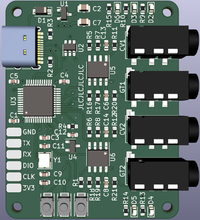Difference between revisions of "MIDItio"
Jump to navigation
Jump to search
| Line 42: | Line 42: | ||
* [https://datasheet.lcsc.com/lcsc/1810251030_STMicroelectronics-STM32L151C8T6_C9861.pdf STM32L151 Datasheet] | * [https://datasheet.lcsc.com/lcsc/1810251030_STMicroelectronics-STM32L151C8T6_C9861.pdf STM32L151 Datasheet] | ||
* [https://www.st.com/resource/en/reference_manual/rm0038-stm32l100xx-stm32l151xx-stm32l152xx-and-stm32l162xx-advanced-armbased-32bit-mcus-stmicroelectronics.pdf STM32L151 Reference Manual] | * [https://www.st.com/resource/en/reference_manual/rm0038-stm32l100xx-stm32l151xx-stm32l152xx-and-stm32l162xx-advanced-armbased-32bit-mcus-stmicroelectronics.pdf STM32L151 Reference Manual] | ||
| + | * [https://github.com/Hypnotriod/midi-box-stm32 STM32 HAL MIDI device example] | ||
Revision as of 03:32, 20 August 2022
MIDItio is a planned USB Midi to CV device. The device will act as a USB MIDI device connected to a USB host. It will be able to run two channels simultaneously with a CV indicating the pitch and a Gate indicating start and stop.
The name MIDItio is derived from MIDI and the Latin "ditio" which means "control".
Planned features are:
- USB MIDI Gadget/Device
- 2 MIDI channels
- Dual pitch CV output (1V/oct)
- Dual gate output
Hardware Design
MCU
The primary concerns dictating the choice of MCU are:
- Built-in USB
- Built-in Digital to Analogue converters (DAC) - preferably 2
- Cost
The STM32L151 fits the bill nicely.
Output Amplifier
Without a boost regulator the highest available voltage on the board is the USB VBUS 5V.

